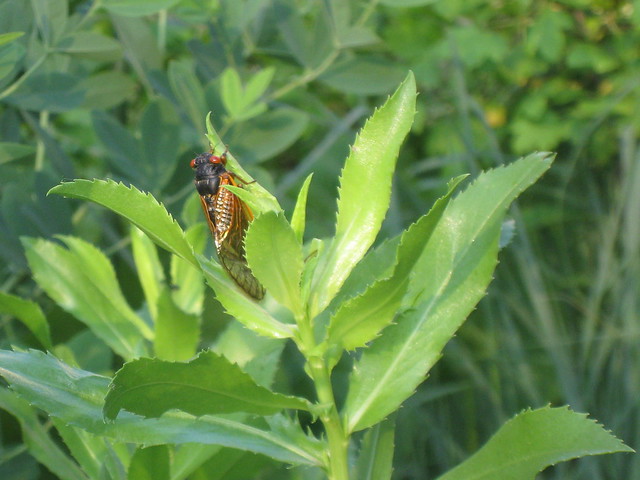 |
| 13-year cicada rests on Gum Plant (Grindelia lanceolata) AMcC |
This year our area is overrun with the "Great Southern Brood," also known as Brood XIX—periodical cicadas, 3 different species in the genus Magicicada. Here's the story: A female periodical cicada lays eggs in a slit she makes in the bark of a twig. The eggs hatch, and the larva drop to the ground, and burrow down to feed on the meager resources of tree roots. In the case of Brood XIX, they will feed for the next 13 years! Then they all emerge, molt into the adult form, mate, and lay eggs. The emerging, molting, and egg laying in my area must all be completed between mid-May and early July.
Why the tag "Great Southern Brood"? First, here's a terrific map of reported sightings, sponsored by the Magicada Mapping Project. As you can see from the map, the greatest cluster of reports comes from midwestern and southern states of the US. Why "great"? Well, the periodical cicada is the sweet gum ball of the insect world. I took a photo of the first ones I noticed on May 17. By May 21, they were everywhere. Hundreds and hundreds of dead cidadas and their exuvia filled my driveway--just like sweet gum balls. Unlike gum balls, however, birds and squirrels helped me clean up.
This week I watched a squirrel climbing a tree. With each bound upward, another 2 or 3 dozen Magicicadas popped out of the top of the tree, till there were hundreds flying over the roofs. So many fly clumsily around me as I work in the yard, they frequently land in my hair or crunch underfoot. Last week I took the dog out in the middle of the night. The next morning I found a dead cicada in my bed. Apparently, I'd acquired a hitchhiker on my back during our short trip, and I'd crushed him overnight.
I was cleaning out my little pond when one dropped dead into the water. No doubt it had fallen from the beak of a Common Grackle, too stuffed with cicada chow to swallow his most recent catch. This is likely the strategy of their almost simultaneous emergence: overwhelm the predators.
Predators may be overwhelmed, but they try to keep up. On the MOBirds listserve, a friend in Columbia, MO. (about 116 miles west of here), reports that she observed Cedar Waxwings gobbling up newly molted cicadas. Their tactic was to perch against the trunk of the tree as a woodpecker might, snatching these delicacies before the exoskeleton hardens. The cicadas have the last laugh however. Predators, such as Cedar Waxwings may raise more young this year because of the bounty, but in 2012 there will be no Brood XIX to feed on.
How can I describe their song? Imagine one of those "rain stick" instruments tipping back and forth. Now imagine about 10,000 more. The males vibrate a membrane on the abdomen called the tymbal to create their own kind of music. The singing can reach over 100 dB, according to the "tymbal" article in Wikipedia. In a different entry, Wikipedia notes that periodical cicadas may number "more than 1.5 million individuals per acre." In my yard, it's comparable to the noise of a nearby lawn mower. Fortunately, Magicicadas are comparatively late risers. By 8:30 AM they're just getting started. They knock off for the day when the shadows get long. By 7:45 PM, not a tymbal was stirring.
The most recent post on Beetles in the Bush describes some differences in the songs of the Magicicada species. Ted has some great photos too, as always. For a recording of the song, check out "Singing Insects of Missouri," published by the Conservation Commission of the State of Missouri, 1998.
You're lucky if they're only as loud as a lawnmower. In my front yard they're painfully loud at times. Earplugs necessary!
ReplyDeleteGreat post, Anne!
ReplyDeleteI think they were louder in 1998--or maybe there are more on the way. Yikes!
ReplyDeleteThanks Beetles! I enjoyed your post about cicadas too! They are everyone's favorite topic these days.
ReplyDeleteI have another post in the works about them - it'll be "different."
ReplyDeleteregards--ted
I'm looking forward to it, Ted. Have you seen the front page of the Webster-Kirkwood Times?
ReplyDelete